Zhengchun Liu
Rapid detection of rare events from in situ X-ray diffraction data using machine learning
Dec 07, 2023Abstract:High-energy X-ray diffraction methods can non-destructively map the 3D microstructure and associated attributes of metallic polycrystalline engineering materials in their bulk form. These methods are often combined with external stimuli such as thermo-mechanical loading to take snapshots over time of the evolving microstructure and attributes. However, the extreme data volumes and the high costs of traditional data acquisition and reduction approaches pose a barrier to quickly extracting actionable insights and improving the temporal resolution of these snapshots. Here we present a fully automated technique capable of rapidly detecting the onset of plasticity in high-energy X-ray microscopy data. Our technique is computationally faster by at least 50 times than the traditional approaches and works for data sets that are up to 9 times sparser than a full data set. This new technique leverages self-supervised image representation learning and clustering to transform massive data into compact, semantic-rich representations of visually salient characteristics (e.g., peak shapes). These characteristics can be a rapid indicator of anomalous events such as changes in diffraction peak shapes. We anticipate that this technique will provide just-in-time actionable information to drive smarter experiments that effectively deploy multi-modal X-ray diffraction methods that span many decades of length scales.
Deep learning at the edge enables real-time streaming ptychographic imaging
Sep 20, 2022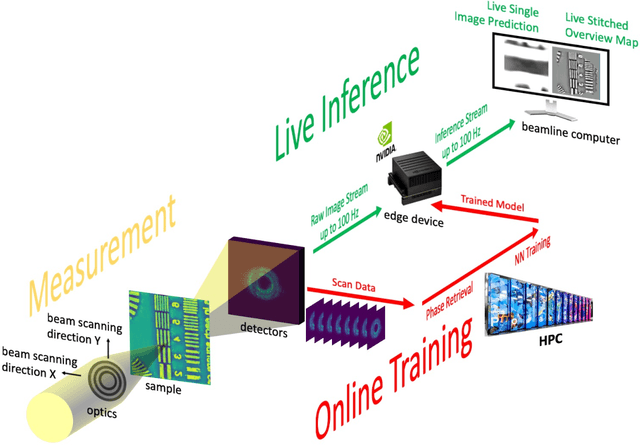
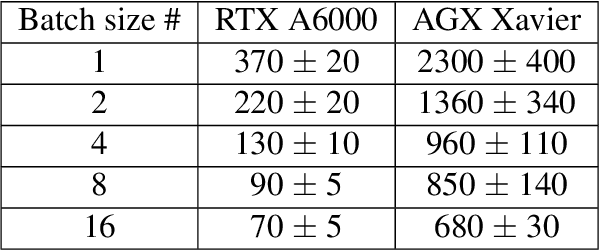
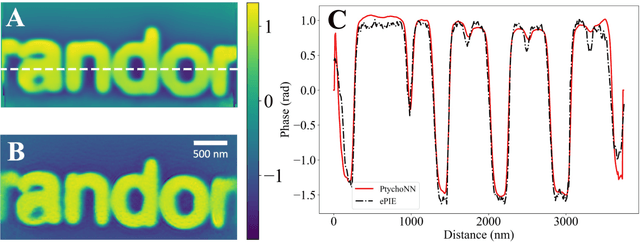

Abstract:Coherent microscopy techniques provide an unparalleled multi-scale view of materials across scientific and technological fields, from structural materials to quantum devices, from integrated circuits to biological cells. Driven by the construction of brighter sources and high-rate detectors, coherent X-ray microscopy methods like ptychography are poised to revolutionize nanoscale materials characterization. However, associated significant increases in data and compute needs mean that conventional approaches no longer suffice for recovering sample images in real-time from high-speed coherent imaging experiments. Here, we demonstrate a workflow that leverages artificial intelligence at the edge and high-performance computing to enable real-time inversion on X-ray ptychography data streamed directly from a detector at up to 2 kHz. The proposed AI-enabled workflow eliminates the sampling constraints imposed by traditional ptychography, allowing low dose imaging using orders of magnitude less data than required by traditional methods.
Masked Sinogram Model with Transformer for ill-Posed Computed Tomography Reconstruction: a Preliminary Study
Sep 03, 2022



Abstract:Computed Tomography (CT) is an imaging technique where information about an object are collected at different angles (called projections or scans). Then the cross-sectional image showing the internal structure of the slice is produced by solving an inverse problem. Limited by certain factors such as radiation dosage, projection angles, the produced images can be noisy or contain artifacts. Inspired by the success of transformer for natural language processing, the core idea of this preliminary study is to consider a projection of tomography as a word token, and the whole scan of the cross-section (A.K.A. sinogram) as a sentence in the context of natural language processing. Then we explore the idea of foundation model by training a masked sinogram model (MSM) and fine-tune MSM for various downstream applications including CT reconstruction under data collections restriction (e.g., photon-budget) and a data-driven solution to approximate solutions of the inverse problem for CT reconstruction. Models and data used in this study are available at https://github.com/lzhengchun/TomoTx.
FAIR principles for AI models, with a practical application for accelerated high energy diffraction microscopy
Jul 14, 2022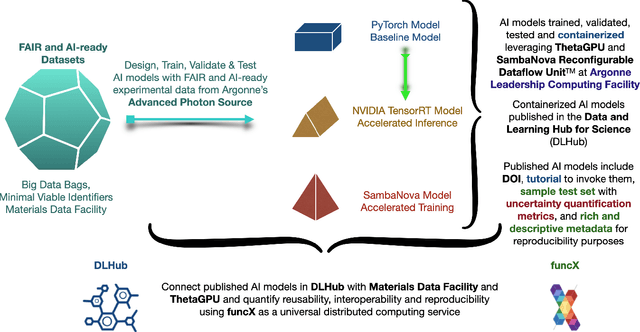
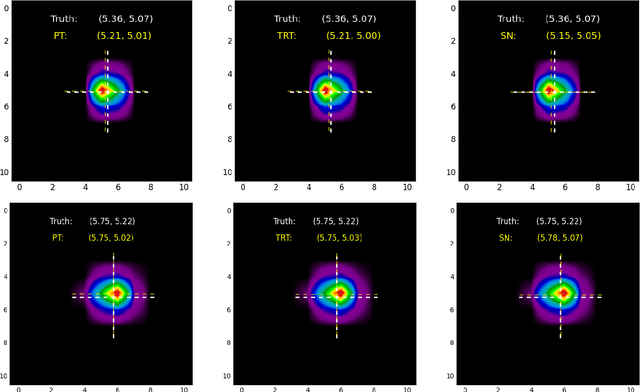
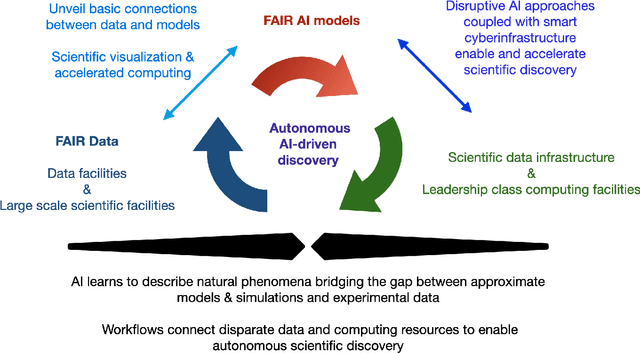
Abstract:A concise and measurable set of FAIR (Findable, Accessible, Interoperable and Reusable) principles for scientific data is transforming the state-of-practice for data management and stewardship, supporting and enabling discovery and innovation. Learning from this initiative, and acknowledging the impact of artificial intelligence (AI) in the practice of science and engineering, we introduce a set of practical, concise, and measurable FAIR principles for AI models. We showcase how to create and share FAIR data and AI models within a unified computational framework combining the following elements: the Advanced Photon Source at Argonne National Laboratory, the Materials Data Facility, the Data and Learning Hub for Science, and funcX, and the Argonne Leadership Computing Facility (ALCF), in particular the ThetaGPU supercomputer and the SambaNova DataScale system at the ALCF AI Testbed. We describe how this domain-agnostic computational framework may be harnessed to enable autonomous AI-driven discovery.
fairDMS: Rapid Model Training by Data and Model Reuse
Apr 20, 2022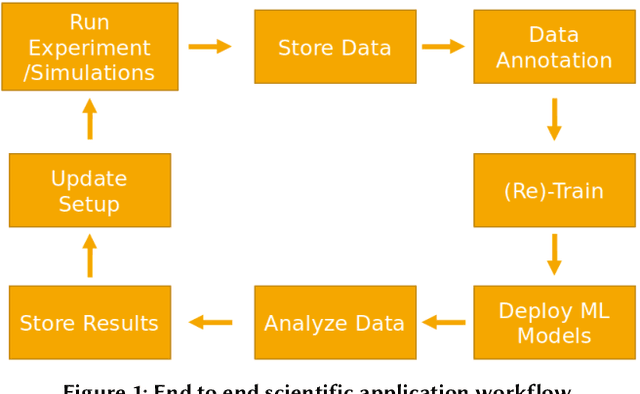


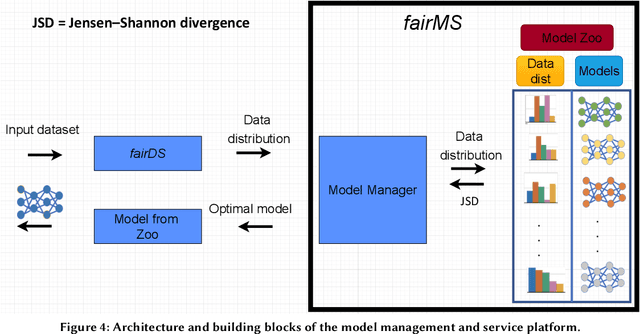
Abstract:Extracting actionable information from data sources such as the Linac Coherent Light Source (LCLS-II) and Advanced Photon Source Upgrade (APS-U) is becoming more challenging due to the fast-growing data generation rate. The rapid analysis possible with ML methods can enable fast feedback loops that can be used to adjust experimental setups in real-time, for example when errors occur or interesting events are detected. However, to avoid degradation in ML performance over time due to changes in an instrument or sample, we need a way to update ML models rapidly while an experiment is running. We present here a data service and model service to accelerate deep neural network training with a focus on ML-based scientific applications. Our proposed data service achieves 100x speedup in terms of data labeling compare to the current state-of-the-art. Further, our model service achieves up to 200x improvement in training speed. Overall, fairDMS achieves up to 92x speedup in terms of end-to-end model updating time.
BFTrainer: Low-Cost Training of Neural Networks on Unfillable Supercomputer Nodes
Jun 22, 2021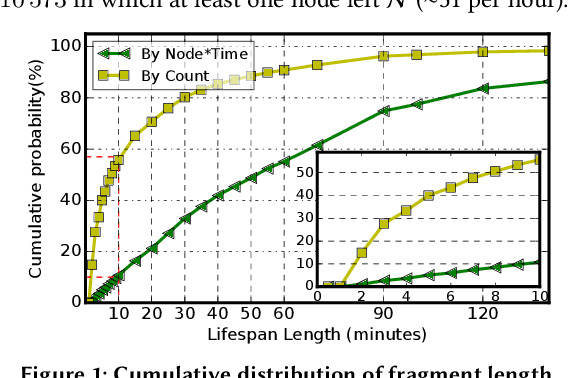

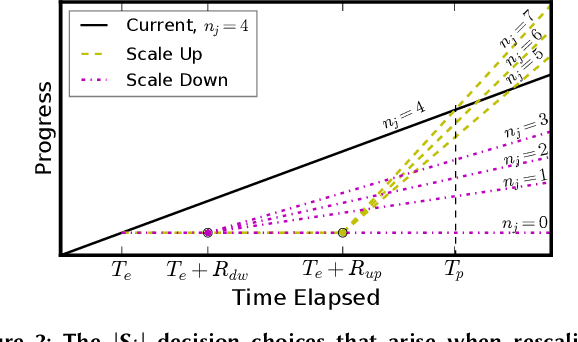

Abstract:Supercomputer FCFS-based scheduling policies result in many transient idle nodes, a phenomenon that is only partially alleviated by backfill scheduling methods that promote small jobs to run before large jobs. Here we describe how to realize a novel use for these otherwise wasted resources, namely, deep neural network (DNN) training. This important workload is easily organized as many small fragments that can be configured dynamically to fit essentially any node*time hole in a supercomputer's schedule. We describe how the task of rescaling suitable DNN training tasks to fit dynamically changing holes can be formulated as a deterministic mixed integer linear programming (MILP)-based resource allocation algorithm, and show that this MILP problem can be solved efficiently at run time. We show further how this MILP problem can be adapted to optimize for administrator- or user-defined metrics. We validate our method with supercomputer scheduler logs and different DNN training scenarios, and demonstrate efficiencies of up to 93% compared with running the same training tasks on dedicated nodes. Our method thus enables substantial supercomputer resources to be allocated to DNN training with no impact on other applications.
Bridge Data Center AI Systems with Edge Computing for Actionable Information Retrieval
May 28, 2021


Abstract:Extremely high data rates at modern synchrotron and X-ray free-electron lasers (XFELs) light source beamlines motivate the use of machine learning methods for data reduction, feature detection, and other purposes. Regardless of the application, the basic concept is the same: data collected in early stages of an experiment, data from past similar experiments, and/or data simulated for the upcoming experiment are used to train machine learning models that, in effect, learn specific characteristics of those data; these models are then used to process subsequent data more efficiently than would general-purpose models that lack knowledge of the specific dataset or data class. Thus, a key challenge is to be able to train models with sufficient rapidity that they can be deployed and used within useful timescales. We describe here how specialized data center AI systems can be used for this purpose.
Fast and accurate learned multiresolution dynamical downscaling for precipitation
Jan 18, 2021



Abstract:This study develops a neural network-based approach for emulating high-resolution modeled precipitation data with comparable statistical properties but at greatly reduced computational cost. The key idea is to use combination of low- and high- resolution simulations to train a neural network to map from the former to the latter. Specifically, we define two types of CNNs, one that stacks variables directly and one that encodes each variable before stacking, and we train each CNN type both with a conventional loss function, such as mean square error (MSE), and with a conditional generative adversarial network (CGAN), for a total of four CNN variants. We compare the four new CNN-derived high-resolution precipitation results with precipitation generated from original high resolution simulations, a bilinear interpolater and the state-of-the-art CNN-based super-resolution (SR) technique. Results show that the SR technique produces results similar to those of the bilinear interpolator with smoother spatial and temporal distributions and smaller data variabilities and extremes than the original high resolution simulations. While the new CNNs trained by MSE generate better results over some regions than the interpolator and SR technique do, their predictions are still not as close as the original high resolution simulations. The CNNs trained by CGAN generate more realistic and physically reasonable results, better capturing not only data variability in time and space but also extremes such as intense and long-lasting storms. The new proposed CNN-based downscaling approach can downscale precipitation from 50~km to 12~km in 14~min for 30~years once the network is trained (training takes 4~hours using 1~GPU), while the conventional dynamical downscaling would take 1~month using 600 CPU cores to generate simulations at the resolution of 12~km over contiguous United States.
BraggNN: Fast X-ray Bragg Peak Analysis Using Deep Learning
Aug 18, 2020


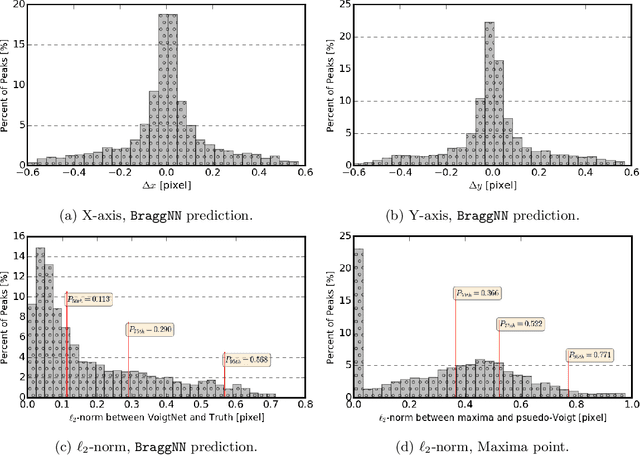
Abstract:X-ray diffraction based microscopy techniques such as high energy diffraction microscopy rely on knowledge of position of diffraction peaks with high resolution. These positions are typically computed by fitting the observed intensities in detector data to a theoretical peak shape such as pseudo-Voigt. As experiments become more complex and detector technologies evolve, the computational cost of such peak shape fitting becomes the biggest hurdle to the rapid analysis required for real-time feedback for experiments. To this end, this paper proposes BraggNN, a machine learning-based method that can localize Bragg peak much more rapidly than conventional pseudo-Voigt peak fitting. When applied to our test dataset, BraggNN gives errors of less than 0.29 and 0.57 voxels, relative to conventional method, for 75% and 95% of the peaks, respectively. When applied to a real experiment dataset, a 3D reconstruction using peak positions located by BraggNN yields an average grain position difference of 17 micrometer and size difference of 1.3 micrometer as compared to the results obtained when the reconstruction used peaks from conventional 2D pseudo-Voigt fitting. Recent advances in deep learning method implementations and special-purpose model inference accelerators allow BraggNN to deliver enormous performance improvements relative to the conventional method, running, for example, more than 200 times faster than a conventional method when using a GPU card with out-of-the-box software.
Scientific Image Restoration Anywhere
Nov 12, 2019

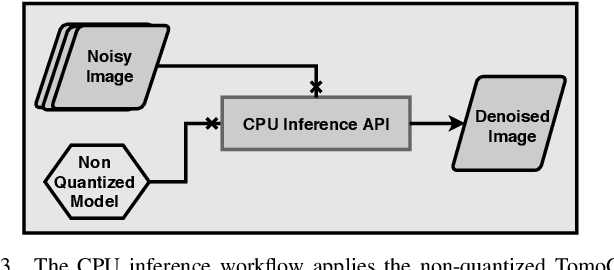

Abstract:The use of deep learning models within scientific experimental facilities frequently requires low-latency inference, so that, for example, quality control operations can be performed while data are being collected. Edge computing devices can be useful in this context, as their low cost and compact form factor permit them to be co-located with the experimental apparatus. Can such devices, with their limited resources, can perform neural network feed-forward computations efficiently and effectively? We explore this question by evaluating the performance and accuracy of a scientific image restoration model, for which both model input and output are images, on edge computing devices. Specifically, we evaluate deployments of TomoGAN, an image-denoising model based on generative adversarial networks developed for low-dose x-ray imaging, on the Google Edge TPU and NVIDIA Jetson. We adapt TomoGAN for edge execution, evaluate model inference performance, and propose methods to address the accuracy drop caused by model quantization. We show that these edge computing devices can deliver accuracy comparable to that of a full-fledged CPU or GPU model, at speeds that are more than adequate for use in the intended deployments, denoising a 1024 x 1024 image in less than a second. Our experiments also show that the Edge TPU models can provide 3x faster inference response than a CPU-based model and 1.5x faster than an edge GPU-based model. This combination of high speed and low cost permits image restoration anywhere.
 Add to Chrome
Add to Chrome Add to Firefox
Add to Firefox Add to Edge
Add to Edge